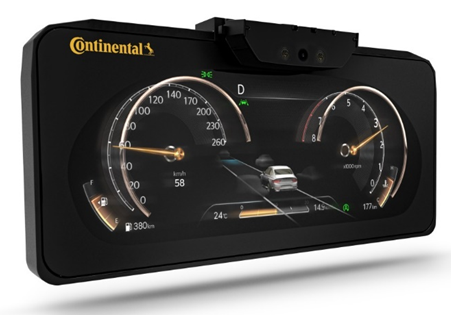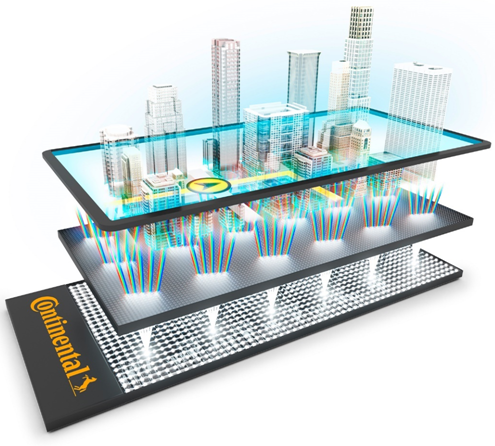Will 3D come to cars before autonomous driving?

Continental aims to revolutionize the way displays are configured in automotive vehicles. The automotive OEM technology company is developing an unusual cockpit solution, the Natural 3D Lightfield Instrument Cluster, in cooperation with Silicon Valley company Leia.
The new design concept promises to bring the third dimension into upcoming automotive vehicles. Lightfield displays are the next generation of medium offering comfortable perception of 3D depth, and the rendering of highlights, sparkles, and other complex light effects.
The technology will, says Continental, enable information to be safely presented to the driver in realtime. That, in turn, will allow the driver´s interaction with the vehicle to become more comfortable and intuitive, claims the company. It could also allow passengers in the front and back seats to share the 3D experience with the driver, suggests Continental.

The prototype of Continental’s 3D instrument panel. (Source: Continental)
The design displays three-dimensional scales, pointers, and objects, for example, displaying a stop sign warning in the driver’s line of sight. No special glasses are required to see the three-dimensional warning signal.
Imagine a stop-sign, shining red, hovering in front of the screen. Rows of houses rise out of the navigation system. The vehicle manufacturer’s logo rotates in the air in front of the dashboard. With these kinds of three-dimensional effects, Continental hopes to revolutionize the way displays are configured in automotive vehicles.
Continental’s interior camera uses eye-tracking to detect the driver’s line of sight and adjusts the 3D views to their precise head position. To prevent drivers from focusing their attention on the 3D screen for too long, the camera also employs attention detection to identify potential moments of driver distraction or fatigue.

Continental is using Leia’s light-field technology for its next-generation 3D display. The system does not require a head-tracker camera. Moreover, Continental claims passengers in the front and back seats can also see the same 3D image from their seated positions—something that was previously not possible and still seems questionable. They can accomplish it, the company says, because the 3D-image produced by the Lightfield display is made up of eight perspectives of the same object that subtly vary according to the point-of-view.
The company says a glance at the Lightfield display will wander when changing the angle from every passenger position—in this way a unique display of information is possible.
“Thanks to our Lightfield display, we achieve a completely new level of 3D-image display,” says Kai Hohmann, Product Manager, Display Solutions at Continental. “The newly developed light conductor with nanostructures is essential for quality. We are not refracting the light, we are bending and guiding it precisely to attain the optimal 3D-effect needed. Only via this technology, it is possible to meet the ever-increasing requirements for comfort and safety within the interior of the vehicle.”
Until recently, either parallax barriers or lenticular techniques were used to achieve a glasses-free 3D effect. They achieve a 3D effect through a special method of blocking or refracting light. Parallax barrier systems, in particular, offer only a single user application by requiring a head tracker system to adjust the 3D views towards the observer´s exact head position. In a similar way, they can negatively impact the perceived image quality and effectiveness of the light output in a multi-user application designed for the driver, co-driver, and rear passenger. For the automotive industry, says the company, the highest quality especially for displaying information is imperative. Continental’s new 3D Lightfield application using Leia’s DLB (Diffractive Lightfield Backlighting) technology offers the next level above conventional 3D displays and enables a crystal-clear screen, even when sunlight is shining directly onto it.
An optical waveguide with diffraction grating and nanostructures beneath the display panel creating a natural 3D effect by bending the light.
“With our volume-production display featuring autostereoscopic 3D technology, we are raising human–machine interaction to a whole new level and laying the foundations for intuitive communication in the connected cockpit of tomorrow,” said Dr. Frank Rabe, head of the Human Machine Interface business unit at Continental. “To ensure that this gain in safety and comfort does not come at the expense of a lean electronics architecture, we integrated various displays in the center console or dashboard into our Cross-Domain Hub.”
To reduce complexity and save weight and space, only a small number of control units will be required for all the in-vehicle input and output devices in the future. The Cross-Domain Hub is a high-performance computer and the basis for Continental’s 3D display being used in the HMC Genesis. It marks a further milestone in the transformation of modern E/E architecture with the intention of moving away from numerous individual control units to a few high-performance computers.
In the next generation of Continental’s cross-domain solution, all displays are integrated into a single unit. The driver will be able to distribute content across multiple displays, for example, by means of gesture control, dragging navigation maps from the front passenger’s display onto their own screen and arranging exactly where they want to place them. In automated driving mode, the displays merge across the entire width of the cockpit and offer all the services and apps that are otherwise only available on the front passenger’s side.
The system is planned for production by 2022. The company showed the prototype of the Leia Display at last year’s CES Asia.
The collaboration with Leia Inc. was initiated by Co-pace, Continental’s start-up organization. Through the Corporate Venture Capital team of Continental, the commitment was further cemented with a minority stake investment. Co-pace enables partnerships of innovative external start-up companies with Continental.
The Leia Display is for future vehicles, but the 3D Display for the Genesis is on the roads right now.
What do we think?
This is one of the most exciting ideas to come to the automotive field in a long time. The only question is will we get 3D displays before we get autonomous cars and don’t need a display. The answer we think is probably yes in that fully autonomous vehicles are probably 10-years off, and the 3D display will be found in cars in two years.
The issue of driver distraction is still one to be considered. Perhaps the display can be turned off if the eye tracker computer senses the driver has or is looking at it too long.





